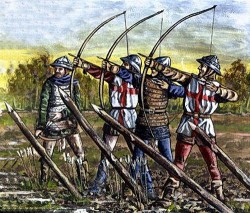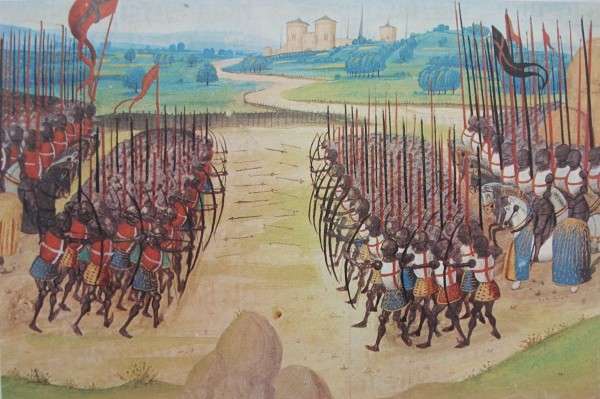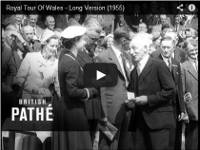Battle of Agincourt 600th Anniversary 2015
Agincourt 600
 The Battle Of Agincourt
The Battle Of Agincourt
The Battle of Agincourt was a battle in the Hundred Years War. It was an English victory. The battle occurred on Friday 25 October 1415.
Henry V of England invaded France. English kings claimed they were heirs to the French throne. In practice the English kings were generally prepared to renounce this claim if the French would acknowledge their claim on Aquitaine and other French lands (the terms of the Treaty of Bretigny).
Henry was negotiating with France about giving up his claim to the throne in return for some concessions by the French. Negotiations broke down when France counter-offered with fewer concessions the English claiming that the French had mocked their claims and ridiculed Henry himself.
Video: Medieval Weapons and Combat - The Longbow (46 minutes)
Video: The battle of Agincourt..The bloodiest battle of the medieval age. (72 minutes)
On 19 April 1415, Henry asked the great council to sanction war with France, and they did. They fought until 8 October. The campaign season was coming to an end, and the English army had suffered many casualties through disease. Henry decided to move most of his army (roughly 7,000) to the port of Calais, the English stronghold in northern France, where they could re-equip over the winter.

After Henry V marched to the north, the French moved to blockade them along the River Somme. They were successful for a time, forcing Henry to move south, away from Calais, to find a ford. The English finally crossed the Somme south of Péronne, at Béthencourt and Voyennes and resumed marching north. Without the river protection, the French were hesitant to force a battle. They shadowed Henry's army while calling a semonce des nobles, calling on local nobles to join the army. By October 24 both armies faced each other for battle, but the French declined, hoping for the arrival of more troops. The next day the French initiated negotiations as a delaying tactic, but Henry ordered his army to advance and to start a battle that, given the state of his army, he would have preferred to avoid. The English had very little food, had marched 260 miles in two-and-a-half weeks, were suffering from sickness such as dysentery, and faced much larger numbers of well equipped French men at arms. However, Henry needed to get to the safety of Calais, and knew if he waited, the French would get more reinforcements.
The battle was fought in the narrow strip of open land formed between the woods of Tramecourt and Agincourt (close to the modern village of Azincourt). The French army was positioned by d'Albret at the northern exit so as to bar the way to Calais. The night of 24 October was spent by the two armies on open ground.

Early on the 25th, Henry deployed his army (approximately 900 men-at-arms and 5,000 longbowmen, the latter commanded by Thomas Erpingham) across a 750 yard part of the defile. (It has been argued that fresh men were brought in after the siege of Harfleur; however, other historians argue that this is wrong, and that although 9,200 English left Harfleur, after a 250 mile march and more sickness had set in, they were down to roughly 5,900 by the time of the battle.)
The French suffered a catastrophic defeat, not just in terms of the sheer numbers killed, but also because of the number of high-ranking nobles lost. It took several years more campaigning, but Henry was eventually able to fulfill all his objectives. He was recognised by the French in the Treaty of Troyes (1420) as the regent and heir to the French throne. This was cemented by his marriage to Catherine of Valois, the daughter of King Charles VI.
Llywel
- John Pyper
- Jeuan ap David ap Jeuan Tew
- David Lonyth
- Meredith ap Traharn ap David Gurteys
- Gwallter ap Gwillim ap Howell Eynon
- Traharn ap Gwillim ap Howell David
- John Alesandre
- Jeuan Coch ap Dooy
- Jeuan ap Griffith Coch
Glyntawe
- David ap Howell ap Gwillelm Lloyt
- Jeuan ap Eynon Bach
- Jeuan ap Morgan ap David ap Mc
- John ap David Dew
- Geffrey Baret
- David Tormour
In the Office of Bailiff Itinerant
- Howell ap David LLOYT
- Rys ap Philip ap Llewellyn
- Deykyn
- Jeuan Dwy ap Howell ap Griffith RaulffJeuan Dwy Ir` royr
- Thomas ap John ap Jake Gam
- David Maur ap Howell
- Walter ap Llewellyn Goch
- Llewellyn Vychan ap Llewellyn Yarlle
- Howell ap Jeuan ap Rees
- Howell Mawr
- Griffith ap Jeuan Vaughan
- David ap Griffith Goch
- Merdith ap Llewellyn ap Jeuan ap Llewellyn Ddwy
- Llewelyn Ddwy ap David Lloyt
- Howell ap Mc ap Griffith Vachan
- Jeuan ap Griffith Lloyt
- Eynon ap Griffith Dew
- Rosser ap Howell ap Griffith ap Madoc
- Jeuan ap Griffith Bach
- Jeuan Dwy ap Rosser
- Thomas ap Griffith Bloith
- Watkin ap Jake Lloyt
- Grifith ap Jeuan ap Howell Veyn
- John Wheler
- David tew ap Howell ap Griffith ap Madoc
- Geffrey Dene
- Jeuan ap Jankyn ap Griffith ap Madoc
- Jeuan ap Trahan ap Gwalter
- Llewellyn ap Rustogyn
- Jeuan Bach ap Glym Goydour
- Glym Dew ap David Ddwy
- Wylcok Smyth
- Griffith ap Jeuan ap Howell ap Jankyn
- Willim Waldebeff Capelanus
In the Office of The Sherriff
- David ap Coch ap Jeuan Methevey
- Jeuan Melyn ap Jeuan
- Rosser ap Jeuan ap Cadogan
- Griffith Fordyn
- Jankyn ap Llewellyn
- Philip Lloyd
- John ap Gurgene
- Howe lap David ap Craham
- Jehan Tew ap Guillim Routh
- David ap Jeuan ap Coffe
- Yanthlos
- Jeuan ap Res Carpenter
- Res Weythe
- John Wynter
- David ap Mereduth Bywell
- David Coke
- Trehan ap Madoc
- Morgan Dwy Leche
- Llewellyn ap Jeuan ap Morgan
- Howell ap Richard
- Jeuan Ferour cum egui cum Waltkin Lloyt
- Meredith ap Trahan ap Jeuan Vachan
- David ap Jeuan ap Howell ap Eynon
- Res ap Gwillim
- Jeuan ap David Gwyn
Meeting to discuss events
This meeting was held on Tuesday 24th November - 25 people attended
- To remember the Battle of Agincourt 25th October 2015
- And to honour archers from Trecastle who fought and gave their lives during the battle
- Please attend and find out more to make the event something to remember, and maybe get involved.
- It'll be successful if more people join in.
- TRECASTLE VILLAGE HALL
- TUESDAY 18th NOVEMBER 2014
- 6PM START




